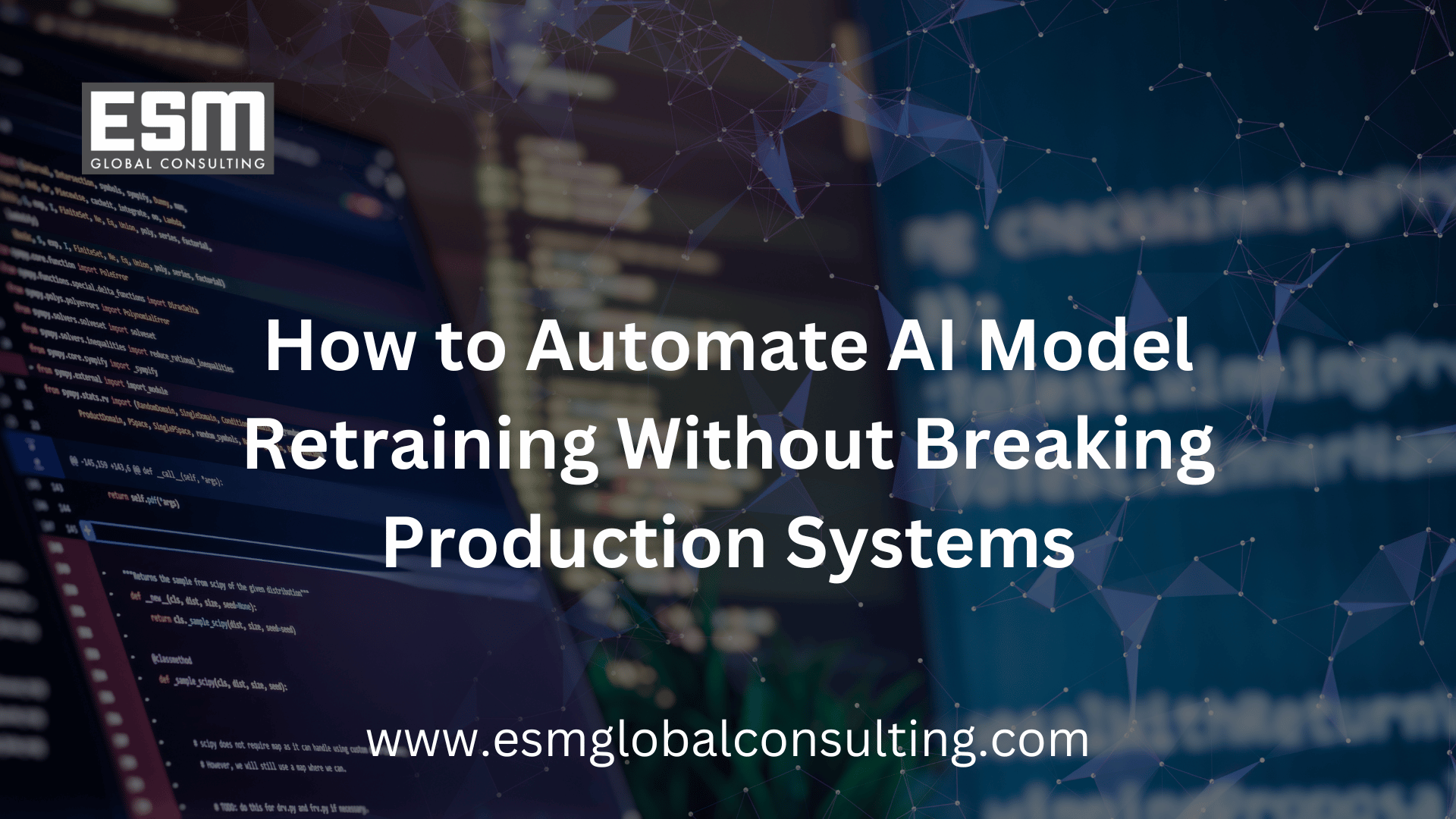How to Automate AI Model Retraining Without Breaking Production Systems
Every successful AI system faces a common problem: data evolves faster than models do.
Customer behavior shifts. Market trends fluctuate. New data patterns emerge. And suddenly, your once-accurate AI begins making questionable predictions.
The solution? Automated model retraining.
But here’s the catch: retraining without care can break production systems, cause downtime, or introduce regressions.
At ESM Global Consulting, we design retraining pipelines that keep AI systems learning continuously while keeping business operations uninterrupted.
Why AI Models Need Retraining in the First Place
Machine learning models are trained on historical data. As that data becomes stale, so do the insights.
Retraining ensures your model stays relevant by:
Adapting to new data trends (e.g., seasonal demand changes)
Correcting performance drift over time
Eliminating emerging bias caused by outdated samples
Aligning with new regulations or updated labeling standards
Without periodic retraining, your AI becomes frozen in time, leading to costly inaccuracies.
The Risk of “Naïve Retraining”
Manual or poorly managed retraining can wreak havoc.
Common pitfalls include:
Downtime: Deploying new models without rollback plans can disrupt services.
Version Conflicts: Overwriting previous models without version control leads to loss of traceability.
Regression Errors: The new model performs worse than the old one under real-world data.
Data Quality Issues: Inconsistent or noisy retraining data degrades accuracy.
Automation eliminates these risks by enforcing consistency, testing, and control throughout the model lifecycle.
Step-by-Step: How to Automate Retraining Safely
Here’s how enterprises can build resilient retraining pipelines that don’t break production:
Step 1: Set Up Continuous Monitoring
Detect data or concept drift using metrics such as population stability index (PSI) or KL divergence. Once drift surpasses a threshold, trigger an automated retraining workflow.
Step 2: Build a CI/CD Pipeline for AI
Adopt DevOps-style automation for model development:
CI (Continuous Integration): Automates model validation, testing, and performance benchmarking.
CD (Continuous Deployment): Automates safe rollout and rollback of models.
Tools like Kubeflow, MLflow, or AWS SageMaker Pipelines make this process reproducible.
Step 3: Use Version Control for Models and Data
Track all experiments and artifacts using Git, DVC, or Weights & Biases. This ensures reproducibility and auditability across every retraining iteration.
Step 4: Test Before You Deploy
Always stage retrained models in a shadow or canary deployment, where the new model runs alongside the old one on live traffic without affecting production decisions. Only promote it once it passes performance thresholds.
Step 5: Automate Rollback Mechanisms
If a retrained model underperforms, the system should automatically revert to the last stable version. No manual firefighting. No downtime.
Tools That Make It Happen
A mature retraining pipeline uses an integrated stack of tools:
| Function | Tools/Frameworks |
|---|---|
| Data Validation | Great Expectations, TFDV |
| Workflow Orchestration | Airflow, Kubeflow Pipelines |
| Model Tracking | MLflow, DVC, Neptune.ai |
| Deployment | Docker, Kubernetes, Seldon Core |
| Monitoring | Evidently AI, Prometheus, Grafana |
ESM leverages these tools, plus custom integrations, to build end-to-end automated retraining systems that fit your infrastructure.
Avoiding Common Pitfalls in Automation
Even with automation, things can go wrong.
Here’s what ESM helps clients avoid:
Blind Retraining: Automating without human checkpoints can amplify data errors.
Resource Overuse: Continuous retraining without performance-based triggers wastes compute.
Poor Documentation: Automation without transparency creates compliance headaches.
The key is to automate intelligently, not endlessly.
The ESM Framework for Continuous Learning
At ESM Global Consulting, we design AI ecosystems that learn responsibly.
Our retraining frameworks include:
Automated data drift detection and alerting
Scheduled and event-triggered retraining pipelines
Model performance dashboards
Version control and rollback automation
Compliance-ready audit trails
With our help, enterprises maintain AI agility without sacrificing stability, traceability, or governance.
Conclusion: Keep Learning, Stay Reliable
AI is not a one-time deployment; it’s a living system that learns, forgets, and adapts.
Automating retraining is how you keep your models fresh, fair, and financially valuable, without risking your production environment.
With ESM Global Consulting, your AI never stops improving, and your operations never stop running.


